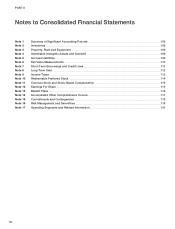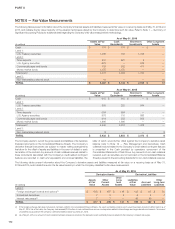Nike 2016 Annual Report Download - page 55
Download and view the complete annual report
Please find page 55 of the 2016 Nike annual report below. You can navigate through the pages in the report by either clicking on the pages listed below, or by using the keyword search tool below to find specific information within the annual report.PART II
Stock-Based Compensation
The Company estimates the fair value of options and stock appreciation rights
granted under the NIKE, Inc. Stock Incentive Plan and employees’ purchase
rights under the Employee Stock Purchase Plans (“ESPPs”) using the Black-
Scholes option pricing model. The Company recognizes this fair value, net of
estimated forfeitures, as Operating overhead expense in the Consolidated
Statements of Income over the vesting period using the straight-line method.
Refer to Note 11 — Common Stock and Stock-Based Compensation for
more information on the Company’s stock-based compensation programs.
Income Taxes
The Company accounts for income taxes using the asset and liability method.
This approach requires the recognition of deferred tax assets and liabilities for
the expected future tax consequences of temporary differences between the
carrying amounts and the tax basis of assets and liabilities. The Company
records a valuation allowance to reduce deferred tax assets to the amount
management believes is more likely than not to be realized. United States
income taxes are provided currently on financial statement earnings of non-
U.S. subsidiaries that are expected to be repatriated. The Company
determines annually the amount of undistributed non-U.S. earnings to invest
indefinitely in its non-U.S. operations.
The Company recognizes a tax benefit from uncertain tax positions in the
financial statements only when it is more likely than not that the position will be
sustained upon examination by relevant tax authorities. The Company
recognizes interest and penalties related to income tax matters in Income tax
expense.
Refer to Note 9 — Income Taxes for further discussion.
Earnings Per Share
Basic earnings per common share is calculated by dividing Net income by the
weighted average number of common shares outstanding during the year.
Diluted earnings per common share is calculated by adjusting weighted
average outstanding shares, assuming conversion of all potentially dilutive
stock options and awards.
RefertoNote12—EarningsPerShareforfurtherdiscussion.
Management Estimates
The preparation of financial statements in conformity with generally accepted
accounting principles requires management to make estimates, including
estimates relating to assumptions that affect the reported amounts of assets
and liabilities and disclosure of contingent assets and liabilities at the date of
financial statements and the reported amounts of revenues and expenses
during the reporting period. Actual results could differ from these estimates.
Recently Adopted Accounting Standards
In November 2015, the FASB issued ASU No. 2015-17, Income Taxes (Topic
740): Balance Sheet Classification of Deferred Taxes to simplify the
presentation of deferred taxes in the statement of financial position. The
updated guidance requires that deferred tax assets and liabilities be classified
as non-current in a classified balance sheet. The Company elected to early
adopt ASU 2015-17 on a retrospective basis in the fourth quarter of fiscal
2016. The adoption of this standard reduced Total current assets by $389
million, increased Deferred income taxes and other assets by $386 million and
reduced Total current liabilities and Deferred income taxes and other liabilities
by $2 million and $1 million, respectively, on the Consolidated Balance Sheet
as of May 31, 2015.
Recently Issued Accounting Standards
In May 2014, the Financial Accounting Standards Board (“FASB”) issued an
accounting standards update that replaces existing revenue recognition
guidance. The updated guidance requires companies to recognize revenue in
a way that depicts the transfer of promised goods or services to customers in
an amount that reflects the consideration to which the entity expects to be
entitled in exchange for those goods or services. In addition, the new
standard requires that reporting companies disclose the nature, amount,
timing and uncertainty of revenue and cash flows arising from contracts with
customers. Based on the FASB’s decision in July 2015 to defer the effective
date and to allow more flexibility with implementation, the new standard will be
effective for the Company beginning June 1, 2018, with early application
permitted. The new standard is required to be applied retrospectively to each
prior reporting period presented or retrospectively with the cumulative effect
of initially applying it recognized at the date of initial application. The Company
has not yet selected a transition method and is currently evaluating the effect
the guidance will have on the Consolidated Financial Statements.
In January 2016, the FASB issued ASU No. 2016-01, Financial Instruments
— Overall (Subtopic 825-10): Recognition and Measurement of Financial
Assets and Financial Liabilities. The updated guidance enhances the reporting
model for financial instruments, which includes amendments to address
aspects of recognition, measurement, presentation and disclosure. The
update to the standard is effective for the Company beginning June 1, 2018.
The Company does not expect the adoption to have a material impact on the
Consolidated Financial Statements.
In February 2016, the FASB issued ASU No. 2016-02, Leases (Topic 842)
that replaces existing lease guidance. The new standard is intended to
provide enhanced transparency and comparability by requiring lessees to
record right-of-use assets and corresponding lease liabilities on the balance
sheet. The new guidance will continue to classify leases as either finance or
operating, with classification affecting the pattern of expense recognition in
the statement of income. The standard is effective for the Company beginning
June 1, 2019, with early application permitted. The new standard is required
to be applied with a modified retrospective approach to each prior reporting
period presented with optional practical expedients. The Company is
currently evaluating the effect the guidance will have on the Consolidated
Financial Statements.
In March 2016, the FASB Issued ASU No. 2016-09, Compensation — Stock
Compensation (Topic 718): Improvements to Employee Share-Based
Payment Accounting. The updated guidance changes how companies
account for certain aspects of share-based payment awards to employees,
including the accounting for income taxes, forfeitures and statutory tax
withholding requirements, as well as classification in the statement of cash
flows. The update to the standard is effective for the Company beginning
June 1, 2017, with early application permitted. The Company is currently
evaluating the effect the guidance will have on the Consolidated Financial
Statements.
108
























